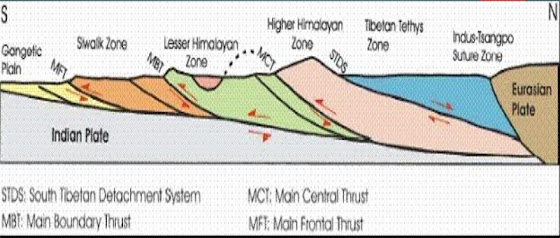Engineering Geology in Himalayas
Major Discontinuities system of the Nepal Himalaya and their Engineering Significance
Discontinuity simply is a plane or surface that marks a sharp change in physical and chemical characteristics in a soil or rock mass.
A discontinuity may be a bedding, schistosity, foliation, joint, fracture, cleavage, fissure or crack, or fault plane.
Discontinuity results in anisotropism and heterogeneity.
These tectonic zones are separated from each other by different faults.
Major Engineering Geological Problems of Nepal HimalayaIndo-Gangetic Plain (Terai) Gangetic Plain that lies in Terai zone of Nepal extends from the Indian side in the South to the Sub-Himalayan (Siwalik) Zone to the North in Nepal. Terai zone has nearly 1500 m thick alluvial sediments and is nearly 200 m above the sea level. The alluvial sediments contain mainly boulder, gravel, silt and clay.
The Higher Himalayan Zone mainly consists of huge pile of strongly metamorphosed rocks. This zone is separated with Tibetan-Tethys Zone by normal fault system called as South Tibetan Detachment System (STDS). It extents from east to west of the country and has different width in different places. Major engineering geological problems of Higher Himalayan zone are: a) Rock fall b) GLOF c) Rock Avalanche d) Snow Avalanche e) Slope Failure
Importance of Engineering geological System in Nepalese Context
Download other files: Download pdf file for major discontinuities system of the Nepal Himalayan in engineering geology Download Hydrogeology-River channel morphology pdf file for engineering geology 1 Glof in the context of Nepal | Causes of Glof in Nepal | Pdf download Hydrogeology in engineering geology slides GLOF in engineering geology slides Major Discontinuities systems of Nepal Himalayan| Engineering geology of Nepal Himalayan slides |

Comments
Post a Comment